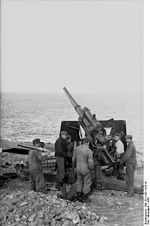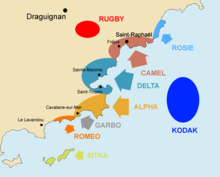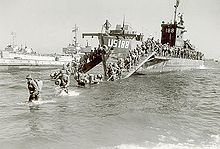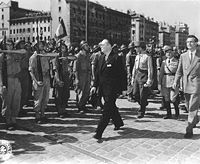- Operation Dragoon
-
Operation Dragoon Part of World War II 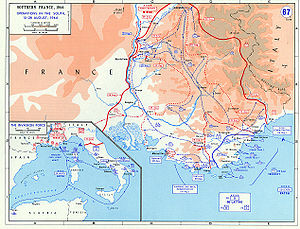
A map of the operation.Date 15 August 1944 – 14 September 1944 Location Southern France Result Allied victory Belligerents  United States
United States
 Free French
Free French
 United Kingdom
United Kingdom
 Canada[1]
Canada[1] Germany
GermanyCommanders and leaders  Jacob L. Devers
Jacob L. Devers
 Alexander Patch
Alexander Patch
 Lucian Truscott
Lucian Truscott
 Jean de Lattre de Tassigny
Jean de Lattre de Tassigny Johannes Blaskowitz
Johannes Blaskowitz
 Friedrich Wiese
Friedrich Wiese
 Wend von Wietersheim
Wend von WietersheimStrength 175,000-200,000 85,000-100,000 in assault area,
285,000-300,000 in southern FranceCasualties and losses  3,000 killed
3,000 killed
4,500 wounded
 ~10,000 KIA or WIA
~10,000 KIA or WIA7,000 killed
20,000 wounded
130,000+ trapped in southern France and later captured[2]Overlord – Dragoon – Paris to the Rhine – Market Garden – Aachen – Hürtgen Forest - Scheldt - Queen – Bulge – Blackcock – Colmar Pocket – Reichswald – Invasion of Germany – End of World War II in EuropePrelude
1939
Phoney War – Saar – The Heligoland Bight
1940
Luxembourg – The Netherlands – (The Hague – Rotterdam – Zeeland – Rotterdam Blitz) – Belgium – (Fort Eben-Emael – Hannut – Gembloux ) – France – (Sedan – Arras – Lille – Calais – Paula – Dunkirk – Dunkirk evacuation – Italian Invasion of France) – Britain - (Adlertag - The Hardest Day - Battle of Britain Day - The Blitz) – Sea Lion
1942–1943
Cerberus and Donnerkeil – St Nazaire Raid – Dieppe Raid
1944–1945
Overlord – Dragoon – Siegfried Line – Market Garden – (Arnhem) – Hürtgen Forest – Aachen – Queen - Scheldt – Bulge – (Nordwind – Bodenplatte) – Colmar Pocket – Invasion of Germany
Strategic Campaigns
The Blitz – Defence of the Reich – Battle of AtlanticNorth Africa – East Africa – Mediterranean Sea – Gibraltar – Malta – Dakar – Balkans – Gabon – Iraq – Syria-Lebanon – Madagascar –Bahrain – Palestine – Iran – Italy – Dodecanese – Southern FranceOperation Dragoon was the Allied invasion of southern France on August 15, 1944, during World War II. The invasion was initiated via a parachute drop by the 1st Airborne Task Force, followed by an amphibious assault by elements of the U.S. Seventh Army, followed a day later by a force made up primarily of the French First Army.[3] The landing caused the German Army Group G to abandon southern France and to retreat under constant Allied attacks to the Vosges Mountains. Despite being a large and complex military operation with a well-executed amphibious and airborne component, Operation Dragoon is not well known; it came in the later stages of the war and was overshadowed by the earlier and larger Operation Overlord.[4]
Contents
Background
During planning stages, the operation was known as "Anvil", to complement Operation Sledgehammer, at that time the code name for the invasion of Normandy. Subsequently, both plans were renamed, Sledgehammer becoming Operation Overlord, and Anvil becoming Operation Dragoon. An apocryphal story holds that the name was chosen by the British prime minister, Winston Churchill, who was opposed to the plan and claimed to having been "dragooned" into accepting it.[5] Other accounts attest that the operation was named after Draguignan, a city near the invasion site. (See the "Landings" map below.)
Operation Dragoon was controversial from the time it was first proposed. The American military leadership and their British counterparts disagreed on the operation. Churchill argued against it on the grounds that it diverted military resources that were better deployed in the on-going Allied operations in Italy; instead, he favoured an invasion of the oil-producing regions of the Balkans.[6] Churchill reasoned that by attacking the Balkans, the western Allies could deny Germany oil, forestall the advance of the Red Army of the Soviet Union, and achieve a superior negotiating position in post-war Europe, all at a single stroke. At the time Operation Anvil was first considered, the Allied landing at Anzio had gone badly and planning was put on ice.
The Operation, now renamed Dragoon, was revived after the successful execution of the Normandy landings, which freed vital amphibious assets. In addition, the Allies were struggling to resupply their growing forces in France, because the Germans had destroyed the port facilities at Cherbourg and a storm had damaged the artificial harbour at Omaha Beach. This made seizure and control of the French ports at Marseilles and Toulon increasingly attractive.[7] The French leaders pressed for an invasion in southern France too. Finally on 14 July 1944 the operation was authorized by the Allied Combined Chiefs of Staff.[6][8]
Opposing Forces
The U.S. 6th Army Group, also known as the Southern Group and as Dragoon Force, commanded by Lieutenant General Jacob L. Devers, was created to carry out the Operation. It was formed in Corsica and activated on 1 August 1944 to consolidate the French and American forces slated to invade southern France. As addition, Task Force 88 was also activated in August to support the landing. It was planned that the forces of the US Seventh Army, commanded by Alexander Patch, would make the initial landing, to be followed by the French Army B commanded by Jean de Lattre de Tassigny.[9] Accompanying the whole operation was a fully mobilized unit called "Taskforce Butler", consisting of the bulk of the Allied tanks, tank destroyers and mechanized infantry. As addition, the French Resistance of the FFI played a major role in fighting, tying down numerous German troops.[10] French resistance fighters also supplied the Allies with vital intelligence information and sabotaged German operations.[11]
In conjunction with the amphibious landing, several airborne operations were planned, conducted by a combined US-British airborne unit, the 1st Airborne Task Force.[12]
Opposing to the Allies was the German Army Group G (Heeresgruppe G). As southern France had never been important to German planning, their forces there had been stripped of nearly all their valuable units and equipment over the course of the war. The remaining 11 divisions were understrength and only one intact Panzer Division was left, the 11th Panzer Division, which also had lost two of its tank battalions. The troops were positioned thinly along the French coast, with an average of 90 km (56 mi) per division. Generally the troops of the German divisions were only second and third grade. This meant that over the course of the years, Germans in those divisions were sent away and replaced with wounded old veterans as well as Volksdeutsche from Poland and Czechoslovakia. There were numerous Ostlegionen inserted, as well as several units made up from volunteered Soviet prisoners of war (Ostbataillonen). The equipment of those troops was in poor shape, consisting of obsolete weapons from various nations, with French, Polish, Soviet, Italian and Czech guns, artillery and mortars. Four of the German divisions were designated as "static", which meant that they were stripped of all of their mobile capabilities and unable to move from their assigned position. The only potent unit inside Army Group G was the 11th Panzer Division.[13]
The German command chain was overly complex, with parallel chains for the occupation forces, the land forces, the Luftwaffe and the Kriegsmarine commands. As part of their defense, the Germans had several fortifications and coastal guns which they had constructed during the years of occupation.[14] The Luftwaffe as well as the Kriegsmarine played a negligible role in the operation.[15]
Planning
Initially, the chief operational objective of Operation Dragoon was the capture of the important French ports of Marseilles and Toulon, which were considered as essential to supply the growing Allied forces in France.[16] The Allied planners used lessons learned from the Anzio and Normandy landings. They chose a location without high ground controlled by the Wehrmacht, as such conditions had forced them to incur heavy casualties after the initial landings at Normandy. The Allies chose an area at the Var coast east of Toulon as the landing site. Prior to the invasion, an air campaign was planned to isolate the battlefield and cut the Germans off from reinforcement by destroying several key bridges. Also a large airborne landing was planned in the center of the landing zone to seize the high ground overlooking the beaches with speed. Parallel to the invasion, several commando units would seize the islands off the coast.[17]
Although the German Command expected another Allied landing in the Mediterranean, the advancing Red Army and the Allied Landing at the Normandy required all German resources, so little was done to improve the condition of Army Group G. Given the advancing Allied forces in northern France, the German Command deemed a realistic defense in the South impossible. Blaskowitz's Army Group G headquarter openly discussed a general withdrawal from southern France in July and August with the German High Command, but the 20 July plot led to an atmosphere in which any withdrawal was out of question. Blaskowitz was quite aware that with his scattered forces any serious Allied landing attempt would be impossible to ward off. He planned the withdrawal in secret, to include demolition of the ports and conduct an ordered withdrawal, covered by the 11th Panzer Division. He intended to establish a new defense line along the town of Dijon in central France. German intelligence was aware of the impending Allied landing, and on 13 August Blaskowitz ordered the 11th Panzer Division to move east of the Rhone-River, where the landing was expected.[18]
Operation Dragoon
Initial landings
The preceding bombing missions together with resistance sabotage acts hit the Germans badly, interrupting railways, damaging bridges, and disrupting the communication network. The landing started on the morning of 15 August.[9]
The assault troops were formed of three American divisions of the VI Corps, reinforced by the French 1st Armoured Division, all under the command of Lieutenant General Lucian K. Truscott, Jr.. The 3rd Infantry Division landed on the left at Alpha Beach (Cavalaire-sur-Mer), the 45th Infantry Division landed in the centre at Delta Beach (Saint-Tropez), and the 36th Infantry Division landed on the right at Camel Beach (Saint-Raphaël). The U.S. 93rd Evacuation Hospital landed at Sainte-Maxime six hours after the initial landings.
The landings were overwhelmingly successful. On Delta and Alpha beaches, German resistance was low. The Osttruppen surrendered quickly, and the biggest threat to the Allies were the mines. A single German gun as well as a mortar position was silenced by destroyer fire. The Allied units in this sector were able to link up with the paratroopers very fast and succeeded in capturing the nearby towns. Only on Camel Beach did the Germans put up some serious resistance. This beach was secured by several well emplaced coastal guns as well as several flak batteries. Here too, the Osttruppen surrendered quickly; the German artillery formed the main opposition and some bunkers provided heavy resistance.
The most serious fighting was on Camel Red Beach at the town of Saint-Raphaël. A bombing run of 90 Allied B-24 bombers were used against a German strongpoint here. But even with the assistance of naval fire, the Allies were not able to bring the landing ships close to the beach. They decided to avoid Camel Red and land only at Camel Blue and Camel Green, which was successful. The Allied casualties at the landings were very light, with only 95 killed and 385 wounded. 40 of those casualties were caused by a Henschel Hs 293 launched from a Do-217, which sank the USS LST-282.[19]
Parallel to the main landings, several special force missions were carried out. At Cap Nègre to the west of the main invasion, a large group of French commandoes destroyed German artillery emplacements (Operation Romeo). These commandoes were supported by other French commando teams that landed on both flanks. In one of those missions, 67 French commandoes were taken prisoner after they ran into a minefield. The airborne and glider landings (Mission Dove, Mission Albatross and Mission Bluebird) around the area of Le Muy accompanying the whole operation, were as successful as the beach landings, with only 434 dead, mostly due to the hazardous landing conditions and not to German resistance.[20] To protect the beachhead, the 1st Special Service Force took two offshore islands (Operation Sitka). Operation Span, a deception plan, was also carried out to shield the main invasion.
German reaction
The Germans were initially confused, because of the cutting of their communication lines by the French Resistance. Blaskowitz started to consolidate his units for the planned withdrawal. With having nearly no mobile reserves to react against the beach landings, he ordered the commander of the 189th Infantry Division, Richard von Schwerin, to establish an ad-hoc battlegroup (Kampfgruppe) of all nearby units to counterattack against Le Muy and the beaches. On the next morning, this battlegroup of now four infantry regiments attacked toward Le Muy from the town of Les Arcs, Var.[21]
By that time the Allies had already landed thousands of troops, vehicles and hundreds of tanks. The Allied mobile forces went out against the German forces at Les Arcs and threatened to cut them off. After heavy fighting the whole day, von Schwerin ordered his troops to retreat in the cover of the night. At the same time heavy fighting occurred in Saint-Raphaël. A battalion of the 148th Infantry Division attempted to counterattack against the beaches, but was repulsed by the Allied forces. The Allies linked up with troops in Le Muy on 17 August.[22]
By the night of 16/17 August, Army Group G headquarters realized that they could not drive the Allies back into the sea. German movement was generally hindered by a Maquis uprising. In northern France, the Falaise pocket threatened the loss of major German forces. Given the precarious situation, Hitler moved away from his "no step backward" agenda and agreed to an OKW plan for the complete withdrawal of Army Group G and B. The OKW plan was for all German forces (except the stationary fortress-troops) in southern France to move north to link up with Army Group B to form a new defensive line from Sens through Dijon to the Swiss frontier. Two German divisions (148th and 158th) were to retreat into the French-Italian Alps. The Allies were privy to the German plan through Ultra interception.[23]
German withdrawal and liberation of the ports
The Germans started to withdraw, while the motorized Allied forces advanced very fast and threatened to cut off major German units. The US 3rd Division pursued the retreating German forces from behind. The Germans tried to establish a defense line at the Rhone to shield the withdrawal of several valuable units (e.g. the 11th Panzer Division). Digne was liberated on 18 August. The 157th Division retreated from Grenoble on 21 August toward the Alps, leaving a large gap in the eastern flank of the retreating Army Group G. Army Group G now decided to sacrifice 242nd Infantry Division in Toulon as well as the 244th Infantry Division in Marseilles to buy time for the rest of Army Group G to retreat trough the Rhone Valley, while the 11th Panzer Division and the 198th Infantry Division would shield the retreat in several defense-lines.[24]
Meanwhile the landed French units started to head for the two ports. After heavy fighting around Hyères, they approached Toulon on 19 August. The ensuing battle lasted until 27 August, when the remaining German units surrendered. The battle for Toulon cost the French 2,700 casualties, but they captured 17,000 Germans. Several Allied warships were also hit by coastal artillery during the fighting.[25] At the same time, the liberation of Marseilles commenced on 21 August. The German units were exhausted from partisan fighting against the FFI. The Wehrmacht was not able to defend on a broad front and soon crumbled into numerous isolated strongpoints. On 27 August most of the city was liberated, with only some small strongpoints remaining. The battle took 1,825 French casualties, but 11,000 German troops were captured. In both harbours, German engineers had demolished port facilities to deny the use of the ports to the Allies.[26]
In the meantime the German retreat continued. The 11th Panzer Division started several feint attacks toward Aix-en-Provence to discourage any further Allied advance. The Allies recognized the open German flank at the east of the Rhone and decided to push with Taskforce Butler, as well as the 36th Division, into this open gap to cut off the German retreat at Montélimar. The Allies occupied the hills near the town and began firing on the retreating Germans. The shocked German command ordered the 11th Panzer Division to deal with this new threat. Meanwhile the Allies strengthened their positions around Montélimar, posing a threat for the whole German retreat. Several hastily assembled counterattacks failed, but on 24 August the 11th Panzer Division arrived and stopped the Allied advance, which suffered from a lack of supply and fuel caused by their rapid progress. On 25 August the Germans attempted a heavy assault on the American positions, which failed. The Allies were able to establish a temporary roadblock, but were thrown back by the 11th Panzer Division shortly after. Over the next days, a stalemate emerged, with Allies unable to block the retreat route and the Germans unable to clear the area of the Allied forces. Finally from 26–28 August, the majority of the German forces was able to escape and on 29 August the Allies captured Montélimar. The Germans suffered 2,100 battle casualties plus 8,000 POWs, while the Americans had 1,575 casualties.[27]
The US VI Corps together with units from the French II Corps pursued and tried to cut off the German forces on their way toward the town of Dijon, while the Germans planned to prevent another Montélimar with a defensive shielding by the 11th Panzer Division. The American 45th Division and the 11th Panzer Division raced north to fulfill their objectives, which led to several heavy engagements at Meximieux, in which the American units took heavy casualties, while the main German units retreated through Lyons. On 3 September Lyons was liberated, but the Germans had already escaped. The Allies made a last ditch attempt to cut the Germans off by taking the towns of Montreval and Marboz north of Bourg, which was thwarted by the 11th Panzer Division in heavy fighting. For the next two weeks more skirmishes occurred and the Allies were not able to cut off a major body of the German forces, but the Germans were also not able to maintain any stable defense line as planned. On 10 September Dragoon units were able to establish contact with units from Patton's Third Army, and the pursuit ended when Army Group G reached the Vosges Mountains.[28]
Aftermath
Operation Dragoon was an outstanding success for the Allied forces. It enabled them to liberate most of France in a timespan of only 4 weeks, while inflicting heavy casualties to the German forces. But, because the battle plan had envisaged stiffer resistance near the beaches, the immediate need for transport was badly underestimated. Fuel consumption outstripped supply and the shortfall proved to be a greater impediment to the advance than the German defence. The Allies were not able to cut off the most valuable units of the retreating Army Group G, which escaped into the Vosges Mountains, leaving over 130,000 troops trapped behind.[29]
An expected benefit of Operation Dragoon was the use of the port facilities at Marseilles. The Allied advance after Operation Cobra and Operation Dragoon slowed almost to a halt in September 1944 due to a critical lack of supplies. Thousands of tons of matériel were shunted to Brittany in the French northwest because the ports at Le Havre and Calais were not yet available to the Allies. Marseilles and the southern French railway system were brought back into service, despite heavy damage inflicted during Dragoon. Eventually, the southern route became a significant source of supplies for the Allied advance into Germany, providing about one third of the total Allied requirement.[30]
See also
- Operation Dragoon order of battle
- Battle of Port Cros
- Battle of La Ciotat
References
Notes
- ^ A significant number of Canadians also took part, both afloat and in the battles in southern France as members of the bi-national US-Canadian First Special Service Force (a.k.a. The Devil's Brigade).
- ^ Zaloga (2009), p. 88
- ^ Zaloga (2009), p. 13
- ^ Zaloga (2009), p. 5
- ^ E. M. Flanagan Jr. (2003). Airborne. Ballantine Books. ISBN 0891416889. OCLC 49327051.
- ^ a b Yeide (2007), p. 13
- ^ Yeide (2007), p. 14
- ^ Zaloga (2009), p. 6-7
- ^ a b Pouge (1986), p. 227
- ^ Zaloga (2009), p. 29
- ^ Zaloga (2009), p. 8
- ^ Breuer (1987), p. 35
- ^ Zaloga (2009), pp. 16-19
- ^ Zaloga (2009), pp. 20-22
- ^ Zaloga (2009), p. 20
- ^ Breuer (1987), p. 46
- ^ Zaloga (2009), p. 34-35
- ^ Zaloga (2009), pp. 32-34
- ^ Zaloga (2009), pp. 41-50
- ^ Zaloga (2009), pp. 38-41
- ^ Zaloga (2009), p. 51
- ^ Zaloga (2009), p. 51-55
- ^ Zaloga (2009), p. 55
- ^ Zaloga (2009), p. 57-59
- ^ Zaloga (2009), p. 59-62
- ^ Zaloga (2009), pp. 62-71
- ^ Zaloga (2009), p. 71-81
- ^ Zaloga (2009), p. 85-88
- ^ Zaloga (2009), p. 88-89
- ^ Zaloga (2009), p. 71
Bibliography
- Breuer, William (1996). Operation Dragoon: The Allied Invasion of the South of France. Presidio Press. ISBN 0891416013.
- Devlin, Gerard M. (1979). Paratrooper: The Saga of Parachute and Glider Combat Troops During World War II. Robson Books. ISBN 0-31259-652-9.
- Flanagan, E. M., Jr. (2002). Airborne: A Combat History of American Airborne Forces. The Random House Publishing Group. ISBN 0-89141-688-9.
- Pouge, C. (1986). United States Army in World War II, European Theater of Operations, the Supreme Command. United States Government Printing. ISBN 0160019168.
- Yeide, Harry (2007). First to the Rhine: The 6th Army Group In World War II. Zenith Press. ISBN 978-0-7603-3146-0.
- Zaloga, Steven J. (2009). Operation Dragoon 1944: France's other D-Day. Osprey Publishing Ltd. ISBN 978-1-84603-367-4.
Further reading
- Leighton, Richard M. (2000 (reissue from 1960)). "Chapter 10: Overlord Versus the Mediterranean at the Cairo-Tehran Conferences". In Kent Roberts Greenfield. Command Decisions. United States Army Center of Military History. CMH Pub 70-7. http://www.history.army.mil/books/70-7_10.htm.
External links
Categories:- Battles of World War II involving Canada
- Battles of World War II involving France
- Invasions
- Naval battles and operations of World War II (European theatre)
- Operation Dragoon
- Western European Campaign (1944-1945)
Wikimedia Foundation. 2010.

